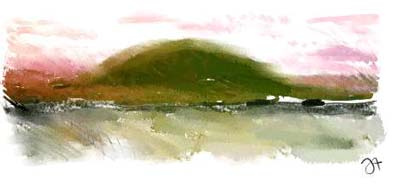
 |
 |
| Home |
| About Orkney |
| History |
| Tradition |
| Folklore |
| Placenames |
| Images |
| Downloads |
| About the Site |
| Contact |
| Links |
| Search Site |
| Awards |
| Orkney's Chambered Cairns | |
Chambered cairns, or tombs, are the most common surviving constructions from Orkney’s Neolithic past. Found throughout the islands, usually visible as low, grassy mounds, these ancient constructions are generally thought to have served as burial places – or, more correctly, repositories of the dead. However, although the word "tomb" has long been used to describe these structures, it is perhaps a slightly misleading label and has lead to a widespread assumption that they only had a funerary purpose. Just as today we would never think to refer to St Magnus Cathedral as a tomb - although any excavator would find no shortage of human remains within its walls - nor should we really label the chambered cairns of the Neolithic as such. Like the cathedral, through the ages, they were probably the focal point for a number of different social, practical or religious ceremonies. The various theories as to the purpose of the chambered cairns are covered here. The earliest Orcadian cairns were built by the first Neolithic settlers - people who crossed the Pentland Firth from the Scottish mainland around the beginning of the fourth millennium BC. The development of the chambered cairn in Orkney spans thousands of years, during which time a variety of different designs were adopted. Though these designs vary, they are now generally been classified as one of two main types - the Orkney-Cromarty type and the Maeshowe-type. These categorisations are slightly misleading, as Orkney’s cairns do not necessarily fit into one category or the other. Instead we have variants of the Orkney-Cromarty cairns containing elements of the Maeshowe-type, while others, such as the Bookan cairn, don’t fit in either. However, as the terminology is fairly widespread, the two main classifications are:
Dating from around 3600-3200 BC, the stalled structures represent the earliest phase of cairn development in Orkney and parallel the design of other early Neolithic buildings in the islands, most notably the house at the Knap o' Howar in Papay. They are also particularly associated with the Unstan Ware style of pottery - shallow, round bottomed pots. As time went on, the designs of the chambered cairns seem to have changed to mirror the evolving architecture of the domestic houses. Maeshowe, for example, representing the final phase of cairn development in Orkney, has a number of architectural similarities with the houses of Skara Brae in Sandwick. By the time of Maeshowe, Unstan Ware was no longer the predominant pottery style, and had been replaced by the more ornate, flat-bottomed pots known as Grooved Ware. The continuous similarity between the domestic dwellings and the chambered cairns of the Neolithic has led to the idea that the cairns were regarded as "houses of the dead" - physical dwelling places for the spirits of the dead, or the ancestors. But it is important to stress that these "houses" were not mere crypts and played a significant role in Neolithic life. From archaeological evidence, we can see that the early Orcadians went to incredible lengths to house the remains of their dead. The construction of a single cairn took considerable time and effort - something that would imply that the dead - or ancestors - of each community were very important to their daily lives. Whether we can class this reverence of the dead as a form of ancestor worship is unclear, but in a society where the average adult is thought to have lived to 30 or 40 years old, it is likely that offspring only knew their elders for a short time before they died. These people may therefore have considered the belief in some form of continuation after death important. In his book, Monuments of the British Neolithic, archaeologist Miles Russell suggests that the use of the chambered cairns allowed the people in each area "stamp" their claim to the surrounding land. The cairns, holding the remains - and therefore spirits - of generations of ancestors, helped justify and strengthen a group’s right to the land. But human remains are not all that has been found within Orkney’s chambered cairns. The discovery of animal bones in some led to the suggestion that some form of animal totemism was practised. The discovery of sea-eagle remains at Isbister in South Ronaldsay and the dog skulls at Cuween in Firth has been at the forefront of this idea. |
Since the beginning of recorded history, Orkney's cairns have always been places of fear and superstition. The widespread idea that they were the hollow-hills of trows and fairy-folk meant that the structures were generally avoided - a superstition that afforded the cairns a degree of protection that has allowed them to us today in a remarkable state of repair and with minimum disturbance. |
